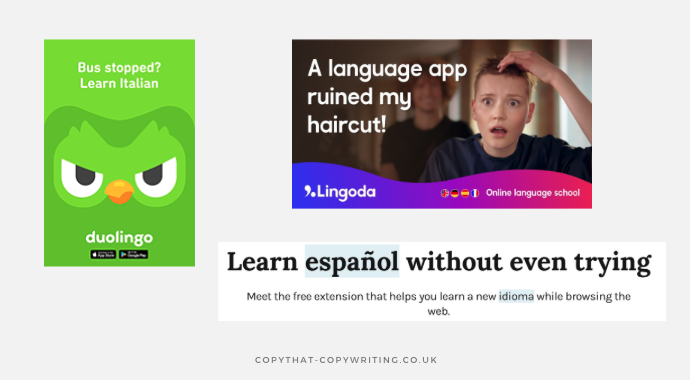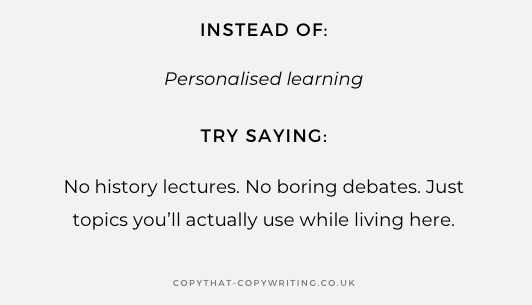Last weekend, I was lucky enough to speak at the Innovate ELT conference, hosted by Oxford TEFL.
I say lucky because not only was this the *best* ELT conference I’ve been to so far, but it also took place in sunny Barcelona. And that was enough to calm this nervy speaker right down.
My talk took place on the first day of the two-day event.
Given that three other talks were happening at the same time, I was convinced no one would show up. I mean, who wants to listen to a marketing presentation at 6:30 on a Saturday evening!? Quite a few people, as it turns out — the room was almost full!
After the presentation, I received some lovely feedback from many of the attendees. So I figured, since most of you couldn’t be there, I’d share a little write-up of what we spoke about.
The conference theme
This year’s conference theme was ‘Power to the Classroom’. Speakers were tasked with presenting a topic which ‘reflects the value of live classroom learning, live zoom learning and the potential of AI and other technology to support or replace these modes.’
As soon as I saw the word ‘value’, I knew exactly what my topic would be. Because that’s marketing in a nutshell — and one of the questions I get asked most often.
So, let’s answer it.
How can you communicate the value of live learning?
I could spend HOURS talking about this topic, but I only had 30 minutes, so we focused on tackling one of the biggest problems I see in language school marketing:
Vague, empty messaging.
You don’t need to look far to find a school or teacher that has an innovative teaching method, takes a personalised approach or uses interactive tools. Nor is it rare to see someone promising to help you… *drum roll please*… SPEAK CONFIDENTLY.
This kind of copy has become so widely used in our industry that it’s almost second nature to describe our services in this way. The problem is, phrases like these mean nothing to the reader. They don’t tell them what those methods or tools entail — or why they should care.
In the past, schools with strong reputations could survive with this messaging. They had brand recognition and social proof on their side.
But the language world is changing. Disruptive EdTech companies like Duolingo, Babbel, Lingoda and Preply have shifted things — not just in the way language is taught, but in the way it’s marketed.
These companies aren’t following the same dusty rulebook as language schools. They’re playing by their own rules, experimenting and having fun with their messaging to meet their audience where they are.
Take a look at these examples:

See how much more engaging this is?
How to make your marketing more engaging
If you’re reading that and thinking ‘I don’t have the budget to advertise on the London tube’, don’t panic. You don’t need to invest in huge marketing campaigns to stand out.
All you need to do is change the way you talk about your services.
Yep, it really is that simple. The words we use to describe our offers shape students’ perceptions of our businesses. They help position us in the market and — you guessed it — show the value we provide.
Words are essentially what makes the difference between someone being convinced to join one language program and scrolling past another.
And the best part is… words are free to use. 🙃
Now before we go any further, I want to clear something up:
Value isn’t defined by what’s gone into building your course. Students aren’t paying for a teacher’s years of experience, teaching degree or the time they’ve spent planning.
They’re investing in what all those things combined mean for them.
This is what’s known in marketing as the ‘benefits’ of your offer — aka the positive impact your service has on your students’ lives.
We can split benefits into two categories: emotional and functional.
Emotional benefits
Emotional benefits illustrate how a student will feel during or after your course. They connect with their motivations for learning the language and the person they want to become.
It’s said that up to 95% of purchasing decisions are made based on emotion. That means we’re more likely to consider buying a product or service that makes us feel a certain way rather than one that purely makes practical sense.
(It’s like buying the sensible school shoes your mum says are a good idea vs the slightly uncomfortable yet super fashionable pumps all your friends are wearing. No brainer.)
Blanket statements like ‘get fluent in English’ don’t connect with learners on an emotional level because they’re not specific enough. In other words, they don’t help them picture exactly how your service will impact their everyday lives.
Identifying the emotional benefits of your offer starts with understanding your students’ goals.
Do they want to chat with their neighbours at their holiday home? Do they need your help to pass an interview for their dream job? Or is their goal to connect with an elderly relative in their first language?
By painting a picture of what your course helps people achieve, you immediately show its value — because you’re answering their most pressing question: “What’s in it for me?”
Here’s an example:

Here, we’re showing students how they’ll be able to use the language in practice and implying a level of confidence they can only dream of right now.
Functional benefits
You may be relieved to hear that we don’t make all of our purchasing decisions based entirely on emotion. Before we commit to anything, we need to rationalise the purchase with logic.
That’s where functional benefits come in. These are the practical advantages your course provides — how your offer makes learning faster, easier or cheaper.
Because as well as looking at what they’ll achieve at the end of the course, students will also be weighing up:
- How much it costs
- How convenient it is to complete
- How easy it is to access
- How much time they need to commit
Functional benefits might be practical but that doesn’t mean they should be boring. You still want to add detail to connect them to your students’ everyday lives.
For example, instead of saying you offer a personalised approach, show how:

In summary?
Communicating the value of live classroom learning — in person or online — all comes down to how you speak about it.
You’ve no doubt experimented with technology to make your courses more modern, accessible and effective. All that’s left now is to translate those things into language that connects with your ideal customers and shows them the real power of the classroom.
And if you’re not sure how?



View comments
Leave a comment